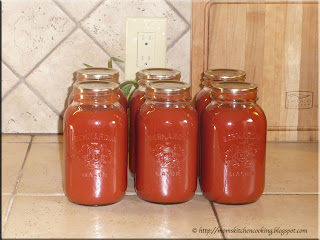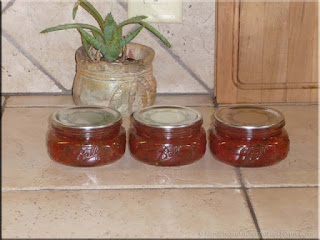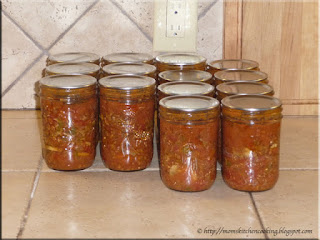I was beyond excited when we bought this house last year knowing full well the fifth bedroom would be used as a full size pantry. The room is located on the lower level of a bi-level home. It is approximately 11' x 10' so has ample storage space. The pantry is home to all of our home canned foods, dried foods, two chest freezers and specialized kitchen appliances. I have spent a considerable amount of time restocking and organizing the pantry over the past few months.
As you enter the pantry to the left (west wall) there is a large closet ( just barely shown to the left). It is home to a few boxes we haven't unpacked yet. I do have a nice over the door rack to hang a few things on the pantry door. The west wall has large plastic storage totes that are going to be replaced with a storage locker. An industrial wire mesh shelving unit hold a lot of staples like baking needs, dried pastas, commercially purchased foods and home canning. Our house backs onto a farm field so everything in the pantry is protected from rodent damage. Rodents did get in last year when the field was harvested but since hiring an exterminator, we have had no problems. Still, everything is protected as we spend an average of three months outside of the country.
The north wall has a nice size window that will end up being blacked out with the new deck in 2013. What I would like to do with that space is turn it into storage as the window well is a good foot deep. I have pails of dry food in recycled ice cream bins (right) and other recycled rodent proof food grade containers. There is a smaller wire rack to house recipe books, canning supplies and basically whatever else I can fit on it. Beside that is our largest chest freezer. We down sized this freezer when we moved to our last house. It is just borderline small but will hold a half a beef with a bit of extra room and it is EnergyStar rated. To the front of the north wall are three boxes of mason jars. I was in the midst of home canning when I took the picture so that's where they were. They will be filled with home canned goodies shortly.
The east wall of the wall has a huge, industrial strength shelving unit we got from one of our friends who has a grocery store franchise during their renovation. It houses a lot of our small kitchen appliances. Not seen but to the back of the top shelf are two knitting machines and on the bottom adjacent to the freezer are boxes of my candlemaking supplies. The second to the top shelf has 206 jars of wonderful home canned tomato product. The bottom shelf is home to home canned products in cases waiting their spot on shelves.
If you look close, I like using painter's tape for labeling. It comes off cleanly without causing any damage to the cartons or shelving. I use a Sharpie to write on it. It's not high tech but it works for us.
The south wall of the pantry is short as that is the entrance wall. It has the smaller freezer, home to poultry, pork and fish. To the corner, there is enough room to stack two rows of empty jars which was stacked to the ceiling before I started the busiest canning season. BSo eside the freezer, there is a small wire shelf that is used for plastics, cook books and extras. I don't have much in the way of plastic storage so don't need a lot of storage space to begin with.
There is a bit of space above the freezer where we are thinking of adding a cabinet. So there is still a fair amount of potential for increasing the storage in our pantry. It is still not fully stocked but I'm working on it. I am pleased that so far the pantry is organized and progressing nicely.
































